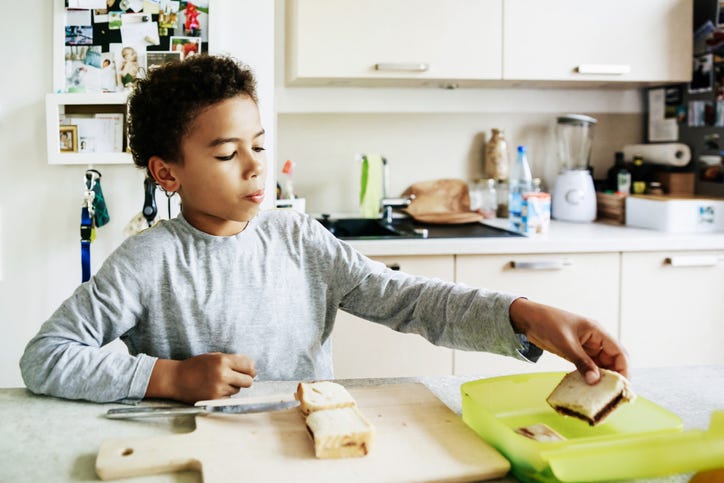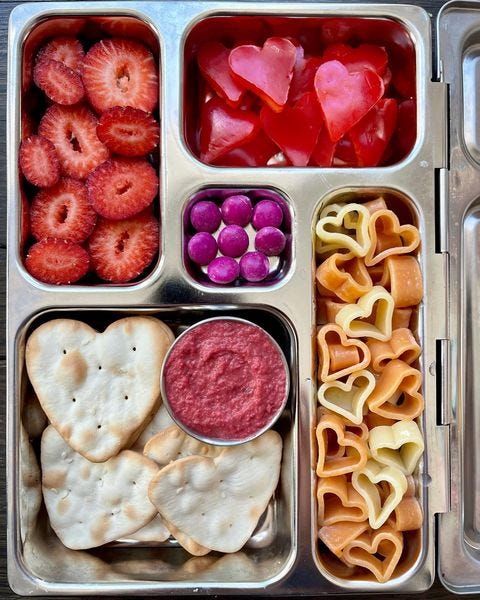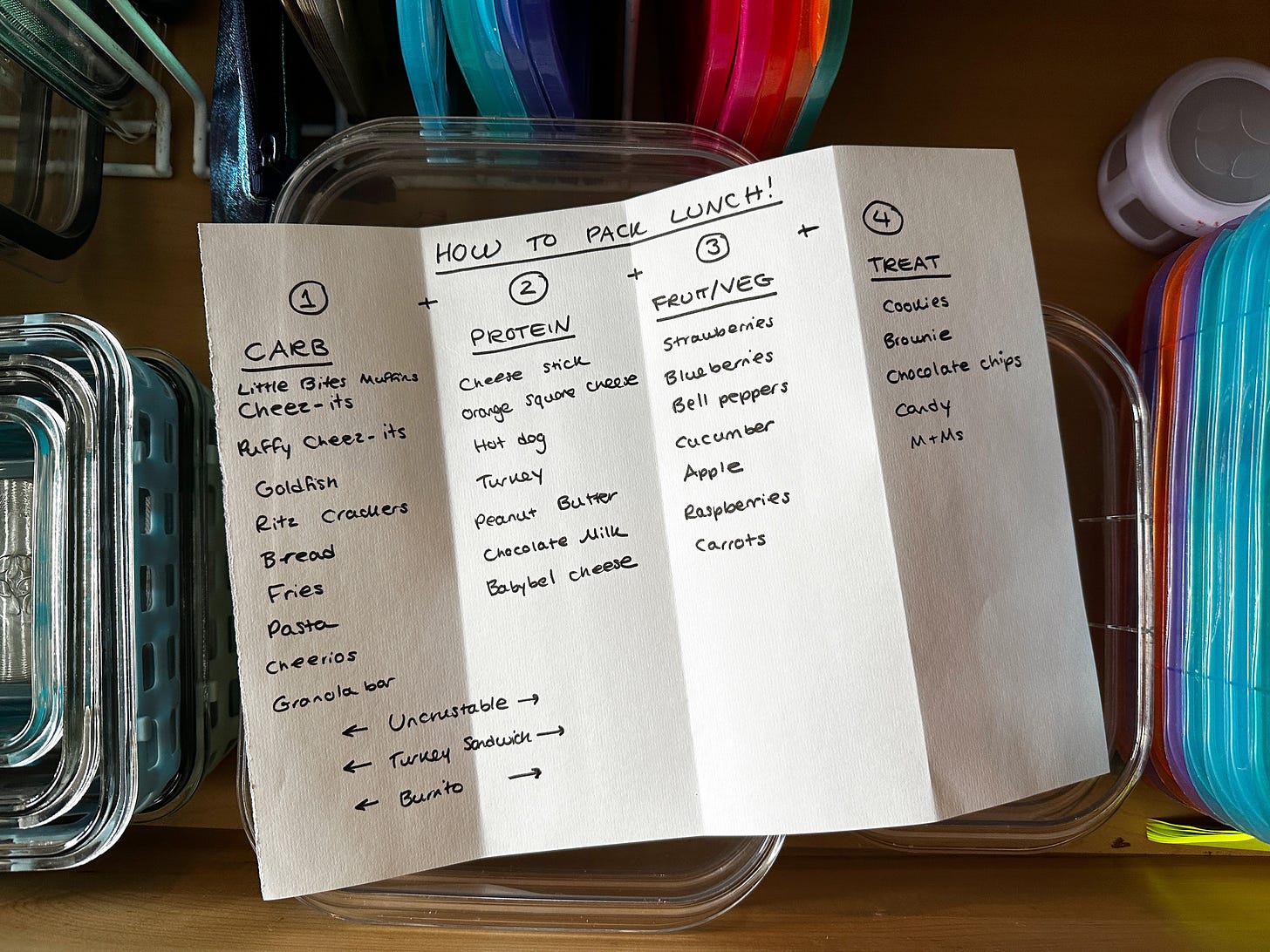To know me, to know Burnt Toast, is to know that I am an enormous fan of school lunch. Not because it’s a perfect system. In many districts, the lines are long, the time to eat is short, and covid-related supply chain issues messed up menus for full school years. School lunch is great because it’s essential: Every child needs to be fed in order to grow and learn, and too many kids in the United States can’t reliably get enough to eat at home. It’s also, on average, higher quality than you think: A 2018 analysis of over 16 years of data concluded that schools “are now the single healthiest place Americans are eating.” And that quality would be even higher if more families participated: “The food-service director of the Austin Independent School District, Anneliese Tanner, told a local news outlet that the district could afford to serve grass-fed beef if the kids who currently opt out of the national program would eat school lunch just once a week,” wrote Jennifer Gaddis, PhD, an assistant professor at the University of Wisconsin and author of The Labor of Lunch, in a New York Times op-ed in February 2020.
So I’ve long been on record as pro-school lunch, and pro-privileged parents getting over our diet culture hang-ups in order to support school lunch. More participation means more funding for school lunch programs, as well as less stigma for the kids who have to eat school lunch because they don’t come from a rainbow bento box-packing home. Beyond the political, opting into school lunches can be great for picky eaters, because kids often try new foods with peers that they’d never touch at home. And—and this part cannot be underscored enough: School reduces the mental load of feeding kids, which is extensive and never-ending, and I will try literally anything to make it easier.
Packing two lunches, plus morning snacks, for two kids with equally rigid yet often quite opposite food preferences, is at minimum, a 15-minute daily project, and that’s before we add on writing cute notes, cleaning out the gross lunch containers at the end of the day, losing the lunchboxes and tracking them down in school lost and found boxes, and dealing with the feedback from children who previously only ever wanted to eat Uncrustables but now absolutely hate Uncrustables. Assuming you allow yourself to pack packaged foods at all, of course: Kid Food Instagram has turned lunch packing into a competitive sport/hobby/religion swirling with rainbows and whimsical food shapes and home made everything.
I want off this particular merry-go-round. Kids don’t need squash cut into star shapes in their $60 stainless steel (not dishwasher safe!) lunchbox to know they are loved. They can eat off cafeteria trays and still get into a good college, or at least not grow up to be serial killers. #TeamSchoolLunch forever.
The problem, of course, is my children.
Farewell, School Lunch?
My girls are now in fourth grade and kindergarten, which means I have been figuring out lunch for children for almost a decade between daycare, preschool, and alternative covid schooling arrangements. This school year, 2022-2023, was supposed to be my retirement party. It is the first year both kids are old enough to be in public school together. And they are attending a public school with a great lunch program. There are hot lunch menus that change daily, pasta on Wednesdays, pizza on Fridays, plus an ever-present sandwich menu as a fallback position. Before the school year began, I announced my retirement. I told my 9-year-old that there would always be something she could eat in the cafeteria, so if she wanted to bring her lunch any day, she had to pack it herself. I told my 5-year-old that the greatest thing about kindergarten is that you get to buy your lunch. I was done.
Then, around Christmas, Beatrix, my five-year-old came home and informed me, accusingly: “A lot of kids actually bring their lunches to kindergarten. It’s allowed.” We also noticed that she was absolutely ravenous in the afternoon and her teacher confirmed that she was frequently not touching anything on her cafeteria tray. She had burned out on her formerly beloved PB&J after eating it daily for four months, and just really, really, really wanted to bring her lunch on the days she didn’t like the menu offerings. I had empathy for all of this. I want her well fed. But I was out of the game, man. How to reconcile my need to never pack lunches again with her need to eat? I told Beatrix the same thing I’d told her older sister: The rule in our family is that kids can bring lunch if they can pack it themselves.
Look, I did not expect this to work. If I’m being very honest, I wanted it to feel a little hard and boring, both because I think it’s okay for kids to have boring chores and because I wanted to motivate her to reconsider her stance on school lunch. I also thought the odds were very high that we would just end up caving and packing for her. This is a child who can’t yet tie shoes or reliably zip her coat all the way up, after all. But she wanted in.
To Pack or Not To Pack?
Before I talk about how we made this work, let’s be clear: There are a lot of very good reasons to pack your kids’ lunch and not feel guilty about it. Kids may not be developmentally ready to handle making those decisions or to navigate all the fine motor skills required to make a sandwich or put blueberries in a snack cup and get the lid on tight. Serious food allergies can require different levels of parental supervision around food prep. And even as kids get older and more clearly capable of handling the (surprisingly many!) discrete tasks involved in lunch packing, parents should stay involved because skipping out on lunch is one way that disordered eating emerges in the tween and teen years. I checked in with Elizabeth Davenport, a weight-inclusive pediatric dietitian and co-author of Sunnyside Up Nutrition, and she offered this perspective:
Tweens and teens are going through a lot of changes: brain development, puberty, and rapid growth during puberty and they need lots of sleep. Their decision making brain is still developing and they often make decision using emotions. They’re going through so much that it can be hard for them to ensure they’re packing themselves enough to eat. And, often, teens and tweens have enough homework and/or activities that they don’t pack lunch at night. Then they’re tired in the morning, so they just throw a snack in a lunch box, or they don’t take any lunch. Because of their rapid rate of growth, not eating enough lunch on a regular basis to support that growth can put them at risk for developing an eating disorder.
If you’re noticing that your child is newly coming home ravenous and eating a ton in the late afternoon and evening, “take that as an opportunity to check in about what they’re packing for lunch,” suggests Elizabeth. Also watch out for trouble concentrating, moodiness, headaches, decreased energy, a decreased rate of weight gain, weight loss, or a new anemia diagnosis (for girls)—all of which can be red flags of an eating disorder regardless of your child’s body size. Elizabeth told me she still packs lunch for her 15-year-old and did the same for her now-college-aged daughter all the way through high school. They have long made their own breakfasts, and handle lunch on weekends, school breaks and during the summer—but this was Elizabeth’s insurance policy that even during busy, high stress school weeks, her kids would eat. And I get it. It’s not that Elizabeth’s (very smart and capable) kids couldn’t handle lunch packing every day with the right scaffolding. It’s that they’re handling a heck of a lot of other things, and this is one stressor she can take off their plate.
My five-year-old, however, does not have a very stressful schedule right now. Beatrix goes to school and comes home to eat snacks and play till we say it’s screen time. Giving her the job of packing lunch immediately filled her with pride—it felt big kid, and cool (especially since she knew her older sister did it), and just tricky enough to be a growth opportunity without inspiring panic or overwhelm. We didn’t sign you up for soccer, kid, but here is a fun new hobby called lunch!
How We Did It
Disclaimer that this is a method I entirely made up, have tested on precisely one child, and it has only been working for about three months. If you want a more in-depth guide, Elizabeth’s co-author Anna Lutz has you covered. But here’s what’s working for us. Some, all, or none of it may work for you.
I showed Beatrix where we keep the lunchboxes.
So here’s where I admit that Kid Food Instagram is onto one thing with their bento box content: It actually makes lunch packing much easier because you’re filling one container, not scrounging around for baggies and snack cups and what have you. We own approximately 47,000 of these Easy Lunchboxes because Amy told me to buy them and she’s always right about this kind of thing. They are way cheaper than the stainless steel bento boxes, super durable (we’ve had ours for over three years), dishwasher-safe, and having a bunch means we can be behind on dishes (our perpetual state of being) and still pack lunch.
I made her this chart.
I know, I know. I told you two weeks ago not to teach your kids about nutrition, and here I am listing out carbs and protein options for a kindergartener. Guys, she doesn’t know what that means. I confirmed this with Elizabeth’s co-blogger, the great Anna Lutz, who says: “At five, she probably can’t truly understand what protein, carbs, etc mean—but she can choose from each group. The categories are a helpful structure for her to put together her lunch.” They are also a somewhat stealth Division of Responsibility because I’m still in charge of the what.
And we aren’t at all rigid about it. “Nutrition gets messy because there are some foods that fit into more than one category and some that fit into none,” notes Anna. I’ve explained that, should Beatrix ever deign to eat a PB&J again, number one she could just buy that from the damn cafeteria, and number two, that covers both the carb and protein categories. I’ve also rolled with it when she’s decided to pick two carbs for lunch (Cheez-Its and a granola bar!) and no protein, or wanted two treats but no fruit or vegetable, or just a fruit and no treat. We don’t need to be overly precise here. Most “carb” foods contain some protein, after all, and most kids don’t need to worry about getting enough protein, nor do they need to eat produce at every single meal of their lives. These categories give us an organizing principle, but they are not strict rules or mandates.
Another way to go on this: Amy tells her kids to pick “a main food” and then “two other foods.” I like this so much because it completely avoids nutrition talk, it just doesn’t work for Beatrix because she doesn’t yet like a lot of “main courses,” especially mixed foods like sandwiches, pasta with sauce, or frozen burritos.
We embrace packaged foods and don’t police food combinations.
You’re probably noticing that our chart is full of snack crackers, pre-cut cheese slices, granola bars, and other processed foods. This is intentional. These are all foods that Beatrix will reliably eat and they are easy for her to get from cabinet to lunchbox by herself. I am sorry about the packaging waste involved, but I am not at all worried about this from a nutritional standpoint. My goal with school lunch is making sure kids have enough to eat so they can learn and get through the day. There are many other opportunities in life for homemade meals.
Somebody stands in the kitchen for moral support.
This is, handily, mostly Dan because he does more of our kids’ morning routine. But one or other of us will generally be unloading the dishwasher while talking Beatrix through the process of picking foods from the chart, locating them in the fridge and pantry, and getting them into her bento box. If she needs help with a particular task (cutting the tops of strawberries or slicing up a hot dog), we do it, we’re not monsters. But we try to be as hands off as is reasonable with a five-year-old who can get distracted from the task at hand because she has a very important anecdote about invisible goats to share.
We have snacks as an insurance policy.
Real talk: I’ve been continuing to pack my kids’ morning snacks all year (and yes, I put in the cute notes, once you start you can never stop). It’s a much lighter lift than lunch used to be, or for sure, lunch plus snacks, but now that they are packing their own lunches most days, I do find myself thinking to add an extra cheese or fruit to the granola bar or whatever, just to make sure they have some other food on hand if they need it. And they get home at 3:45pm and have their afternoon snack here, followed swiftly by dinner and a bedtime snack if they want it. If they were in aftercare or had a lot of extracurricular activities, I’d want to make sure they had more snacks (packed or provided) to cover that long stretch between lunch and dinner.
Is it Working? Will We Keep Doing It?
Ugh, yes and probably yes. I still dream of my kids buying lunch five days a week and me knowing nothing about it beyond the monthly top-up of the MySchoolBucks account. We now check the cafeteria menu at the start of the week and they each pick one or two days to buy. On those days, I make sure to hype how great it is to have extra playtime before the bus because they don’t have to do the work of packing their lunch! I’ve also explained why it’s so important that schools have lunch programs and how this benefits their less privileged peers.
I do not think we are adding value to their lives with packed lunches. I do like that we’re making the labor of food visible to them and that they are participating in the work of the household. But every skill they are mastering with this project could be learned in some other part of their day. So if you have kids who are happy with school lunch, please do not break what isn’t broken. But if it’s not working consistently and you have to go back to packing, just know that the semi-retired school lunch life is still possible.
And: Just this morning, as I finished editing this essay, Beatrix decided to buy a cafeteria PB&J instead of packing because she wanted more time to play. Long live school lunch.
[Post-Publication Note: Several of you have informed me that the PlanetBox, the $60 stainless steel lunchbox featured in the Weelicious post above, is, indeed, dishwasher-safe. Apologies for that fact-checking oversight!]
My Kids’ Favorite Lunches
Please remember that I am not a food blogger (though I am best friends with one!) or a dietitian, and again, we are relying heavily and without apology on packaged staples to make school lunch happen right now. But if that’s your boat too, here are five lunches my kids can reliably pack themselves and seem to really/mostly enjoy eating. (Please also note that nothing here is intended to be a portion size; your kids may be more or less hungry than mine and that is totally normal and great!)






